Projects are listed in alphabetical order by students surname, click on image to view poster larger:
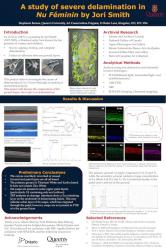 Study of Severe Delamination in Nu Féminin (1967), by Montreal Artist Jori Smith
Study of Severe Delamination in Nu Féminin (1967), by Montreal Artist Jori Smith
Stephanie Barnes
The painting, Nu Féminin (1967), by Montreal artist Jori Smith (1907-2005), was donated to the Master of Art Conservation (MAC) program in 2012. It is in very poor condition, undergoing severe cupping, tenting, and complete delamination affecting the entire paint surface. The cupped paint flakes are, in some cases, as much as 5 cm in diameter. The primary goal of this study is to analyze and identify the materials used, with the goal of determining the cause of this delamination. This will include non-destructive and minimally invasive analysis using techniques including polarized light microscopy, Fourier-transform infrared spectroscopy and X-ray fluorescence. The study will also include a more general investigation of the materials, techniques and conservation issues in Nu Féminin. This will be compared with other paintings by the artist, using information compiled from museum visits, consultation of condition and treatment reports, and archival research. Possible treatments approaches for paintings with similar degradation issues may also be discussed.
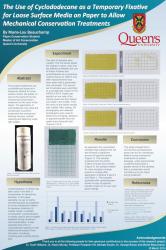 The Use of Cyclododecane as a Temporary Fixative for Loose Surface Media on Paper to Allow Mechanical Conservation Treatments
The Use of Cyclododecane as a Temporary Fixative for Loose Surface Media on Paper to Allow Mechanical Conservation Treatments
Marie-Lou Beauchamp
Cyclododecane (C12H24) has been used in the field of conservation for almost two decades. In the paper speciality, its use has mainly been oriented towards its properties to act as a temporary fixative for aqueous treatment of soluble media. In artefact conservation, cyclododecane is mostly used to secure fragile artefacts during movement and transportation. This study proposes to use cyclododecane spray as a temporary fixative for loose surface media, like pastel, to secure the pigments during mechanical conservation treatment on the verso of the object. The application of cyclododecane may allow the conservator to perform treatments like mechanical backing removal, surface cleaning and flattening under light weight. Samples will be created by applying pastel on paper and then applying a coating of cyclododecane. Then, the samples will be submitted to a smudge test, based on the ASTM Standard Test Method for Determination of Abrasion and Smudge Resistance of Images Produced from Business Copy Products. After sublimation of the cyclododecane, assessment of the change in colour and glossiness will be made with colorimeter and glossmeter. UV photography and reflected photography will be used to detect any smudging, abrasion or pigment transfer from the sample during the test. It is expected that a film of cyclododecane applied on the media would protect it from disruption, smudging, smearing and crushing during test. Since the conditions of experiment would place a greater stress on the samples than a conservator would normally put on an object during treatment, the hypothesis is that a commercial cyclododecane spray can act as a temporary fixative to perform mechanical treatments on pastels drawings.
The Use of Glass Microballoons to Modify the Mechanical Properties of a Commercial Filler Material: The Flügger Acrylspartel
Mélanie Cloutier
Commercial ready-made filler materials are widely used in the field of art conservation. Most ready-made filler materials are reactive to fluctuations of relative humidity. Dimensional changes in filler materials are an issue in conservation because damage can happen to the material surrounding the filled areas if the filler material expands or shrinks too much. In this research, the addition of glass microballoons (0.25g/cc, isostatic crush strength 750 psi) in a ready-made filling material, Flügger Acrylspartel, was investigated. The goal of this research is to determine if the addition of microballoons can decrease the dimensional changes from fluctuations of relative humidity, without affecting other mechanical properties of the filler material. The addition of microballoons in adhesives is known to improve reversibility and dimensional stability over time, to decrease tensile strength if higher concentrations are used, to decrease the density of overall material, to decrease its shrinkage properties during drying, to decrease flexibility, and to increase hardness. Various concentrations of glass microballoons were added to Flügger Acrylspartel. Flexibility and tensile strength were tested. In addition, handling and modeling properties, dimensional changes under high relative humidity (73%), and shrinkage upon drying were recorded. This research will determine if properties of ready-made filling materials can be modified easily in order to obtain a more stable material. Superior filler properties could be adapted for specific materials, such as rigid supports.
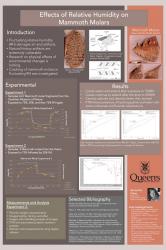 Examining the Effect of Relative Humidity on Mammoth Molars
Examining the Effect of Relative Humidity on Mammoth Molars
Samantha Fisher
Over the years, conservators have seen that fluctuations in relative humidity can have a damaging effect on art and artifacts. Natural history collections often contain extremely vulnerable artifacts, but there is a lack of thorough research on physical effects to environmental changes. In order to understand better how the most vulnerable materials in natural history collections respond to fluctuations of relative humidity, samples of mammoth molars (and shells) will be examined by finding the critical relative humidity at which physical damage first occurs. Sub-fossil mammoth molars are sensitive objects composed of closely packed enamel plates with layers of cement and dentine. Deteriorated mammoth molars show fracturing of the layers, powdering, and cracking throughout. Relative humidity chambers controlled by salt solutions will be used to subject the samples to specific environments, mainly in decreasing increments until there are visible physical changes. The samples will be measured and documented before and after the experiments using photogrammetry. Any changes during the experiments will be documented by weighing the samples periodically and by analyzing and taking photographs of the samples under a microscope. Sorption response times of small samples of material to changes in relative humidity will be analyzed using an automated sorption isotherm device at the Canadian Conservation Institute (CCI). All research is performed in conjunction with Rob Waller and with the assistance of the conservation scientists at CCI and Queen’s University.
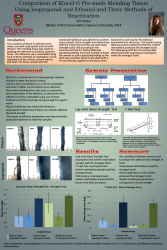 Comparison of the Preparation of Klucel G Pre-made Mending Tissue Using Isopropanol and Ethanol and Three Methods of Reactivation
Comparison of the Preparation of Klucel G Pre-made Mending Tissue Using Isopropanol and Ethanol and Three Methods of Reactivation
Erin Kraus
Klucel G pre-made mending tissue will be made with either isopropanol or ethanol. Kizukishi Japanese tissue will be used to make the mending tissue. Three methods of reactivating the adhesive will be tested by brush application of the solvent, solvent vapour, and heat. The pre-made mending strips will be used to prepare appropriate samples for the T-Peel Test and the Lap Joint Shear Strength Test according to the American Society for Testing Materials standards (ASTM). In addition to the strength tests, a dye that marks hydroxypropyl cellulose will be added to the samples and analyzed with microscopy to compare the bonds between the adhesive and the tissue to determine which solution diffused into the tissue better. The data will be used to confirm which of the solutions and which activation technique produced the strongest bond. This will help determine which methods are the most appropriate for use with pre-made mending tissues in conservation.
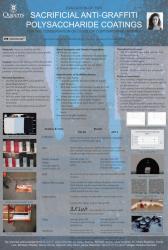 Evaluation of Two Sacrificial Anti-Graffiti Polysaccharide Coatings for the Conservation of Outdoor Contemporary Murals
Evaluation of Two Sacrificial Anti-Graffiti Polysaccharide Coatings for the Conservation of Outdoor Contemporary Murals
Laurence Gagné
In recent years, the conservation of outdoor contemporary murals has attracted much attention and concern as many murals were in a serious state of decline. The issues surrounding the preventive and active conservation of outside contemporary murals are numerous and multidimensional. Among these, the increasing issue of graffiti vandalism is probably one of the most damaging to murals. The efficacy of the PSS 20 and the APP S, two sacrificial anti-graffiti polysaccharide-based coatings, were tested in this study. These coatings are described by their manufacturers as being easily reversible, clear, non-toxic, biodegradable, environmentally friendly, and compatible with most surfaces including painted surfaces. They thus present promising proprieties. The objective of this study was to verify the efficacy of new products providing new tools to artists, conservators and concerned authorities, to face the growing challenge of graffiti vandalism. PSS 20 and the APP S were tested for their stability and reversibility in response to accelerated aging and graffiti vandalism. Mural surrogates were prepared on two different substrates: red clay bricks and cement boards. The substrates were covered with a layer of high quality primer, an excellent lightfast acrylic paint layer and then with the anti-graffiti coatings PSS 20 and APP S. The properties of the coatings including pH, colour, gloss, adhesion, abrasion resistance, and overall surface appearance were measured before and after accelerated aging. The ability of the coatings to act as a barrier layer against graffiti was evaluated at three different times: before, after three years and after ten years of artificial aging. A layer of spray paint and felt marker was applied to the surrogates. After graffiti and coating removal, cross sections of the surrogates were made and evaluated with optical and scanning electron microscopy; possible abrasion of the paint surface and penetration of graffiti materials was evaluated. In order to study their chemical deterioration, the coatings were analysed with Fourier transform infrared spectroscopy (FTIR), size exclusion chromatography (SEC), and water contact angle. These analyses were performed through the different stages of aging. The experimental results of this study will provide new insights about the efficacy of the anti-graffiti coatings PSS 20 and APP S.
Critical Analysis of Structured Light Scanners for the 3D Imaging of Ancient Ceramics
Emily Ricketts
This research will aim to create viable digital replicas of ancient ceramic vessels through structured light 3D scanning while assessing the role this advancing technology holds both practically and ethically for the conservation field. Through multiple scans of each object, this project should help establish comprehensive instructions for setting up the scanner quickly and efficiently, securing the ceramic vessels through the scanning process, and obtaining consistent digital images that contain as much detail as possible. The main software used with the structured light scanner will be Flexscan© 3.1. The recent upgrade of this user-friendly program has introduced the ability to add colour to the 3D images. This research will examine the ability of the colour-capturing feature to mimic traditional photo studio documentation. The capture of RAW images during the initial scanning process will allow for separate 3D models to be created digitally using photogrammetry software, such as Agisoft©. This will accommodate further comparison of the virtual 3D reproductions created with the structured light technique with those of other popular digital archive methods. An objective analysis of the scanner for object documentation and academic sharing purposes will be important in this project. Aside from the practical and technological aspects of this research, 3D scanning technologies will be placed under ethical investigation by discussing how the cost and creation of a digital copy of an artifact can change how we treat, handle, and view the object itself.
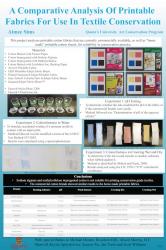 A Comparative Analysis of Printable Fabrics for Use in Conservation
A Comparative Analysis of Printable Fabrics for Use in Conservation
Aimee Sims
Wide format inkjet printing on textiles can be performed by professional printers and museums with large budgets, however, there exists no product that will allow conservators to print conservation-grade textiles themselves using a commercial inkjet printer. This research project outlines the components needed to create such a product and begins by analyzing printable cotton fabrics that are currently commercially available, as well as “home-made” printable cotton sheets, for suitability in conservation practice. Analysis of these prepared fabrics will determine if an appropriate product already exists or if a new way of preparing fabrics for printing needs to be designed. Fabrics to be tested are: cotton backed with freezer paper, cotton impregnated with sodium alginate, cotton impregnated with methylcellulose and various commercially available products. Methods of analysis used will include pH, colorimetry testing, wash fastness and crock fastness when printed on with cyan, magenta, yellow and black pigment ink. It is expected that the “home made” backed fabrics might have difficulty passing through the printer, but that the combination of no pre-treatment and stable inks will produce positive results. The commercially available printable fabrics should print well but might not pass the stability tests, due to adhesive residues from the backing paper or chemical pre-treatments that they have undergone.
Marc-Aurèle de Foy Suzor-Coté (1869-1937): A Study of the Painting Entitled Wet Snow, Arthabaska
Marc-Aurèle de Foy Suzor-Coté was one of the first Canadian artists to develop a national art rooted in the Canadian identity. He was inspired by Impressionism and painted along other great Canadian artists including Alfred Laliberté, Maurice Cullen and James Wilson Morrice. The Agnes Etherington Center Art (AEAC) recently acquired the painting Wet Snow, Arthabaska (1910-1919) attributed to the artist; however, the authenticity of this painting has been called into question. This research investigates Suzor-Coté’s authorship of the painting. Information about Suzor-Coté’s painting materials and techniques were be obtained through art historical research. Comparisons were made of the materials, techniques and conservation conditions of paintings by Suzor-Coté from the same period in other collections. Technical analysis, both non-destructive and micro-destructive, were carried out. Non-destructive analytical methods included photographic examination using normal illumination, infrared radiation (IR), ultraviolet illumination (UV) and x-ray fluorescence (XRF) spectroscopy. Micro-destructive analytical tools were also used to analyze paint samples and canvas fibres. They include polarized light microscopy (PLM), Fourier transform infrared spectroscopy (FTIR), scanning electron microscopy-energy dispersive x-ray spectroscopy (SEM-EDS), and gas chromatography-mass spectroscopy (GC-MS). Finally, a small wood panel painting similar to Wet Snow, Arthabaska was found in a private collection. Suzor-Coté’s student Rodolphe Duguay enlarged some of Suzor-Coté’s sketches and small paintings using the grid system that were than signed by Suzor-Coté. It has been established that Wet Snow, Arthabaska might be a collaboration between Suzor-Coté and Duguay since a grid was found under the paint layer through infrared analysis and that the painting style is different from Suzor-Coté’s style, but the material seems similar. This research gave information to establish whether or not Wet Snow, Arthabaska was a forgery and serves to understand Suzor-Coté and Duguay’s painting techniques which will aid in future conservation treatments of Suzor-Coté’s artworks.
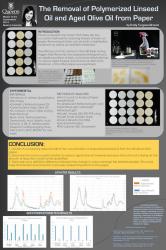 Reducing Linseed and Olive Oil Stains from Paper Using Three Prepared Solutions and Shout® Triple Acting Stain Remover
Reducing Linseed and Olive Oil Stains from Paper Using Three Prepared Solutions and Shout® Triple Acting Stain Remover
Emily Turgeon-Brunet
Previous research has shown that there are few successful methods for reducing drying oil stains on paper. Removing oil stains can be both a necessary treatment as well as an aesthetic treatment, to gain information and improve appearance. In the past, solvents, bleaching agents and lipase enzymes have been tried, but oils are quite complex and it is likely that either a combination of treatments is needed, or a new direction should be taken. The capabilities of SC Johnson’s Shout® Triple Acting Trigger, to reduce or remove oil stains from paper, will be investigated and compared to three prepared solutions. Shout is a commercial product that was created to remove stains from clothing. The efficacy of the commercial product will be compared to two prepared detergents and one alkaline methyl cellulose poultice. Refined linseed oil and pure extra virgin olive oil will be used to stain Whatman cotton filter paper samples and then the papers will be artificially aged for seven days at 80% RH and 50˚C. The three prepared solutions and the commercial solution will be applied to the stains and left on for 25 hours. Finally, the solutions will be washed out of the samples by aqueous immersion treatments. Before and after treatment analysis will be done on the samples to look for a reduction of the oil stains, using attenuated total reflectance Fourier transform infrared (ATR-FTIR) spectroscopy, a spectrophotometer for colour measurements, a pH metre, a gloss metre, and the Print Council of America Paper Sample Book (PCAPSB). It is expected that the ATR-FTIR spectra will indicate if there is a change in the concentration of the oil stains after they are treated by exhibiting different peak intensities.